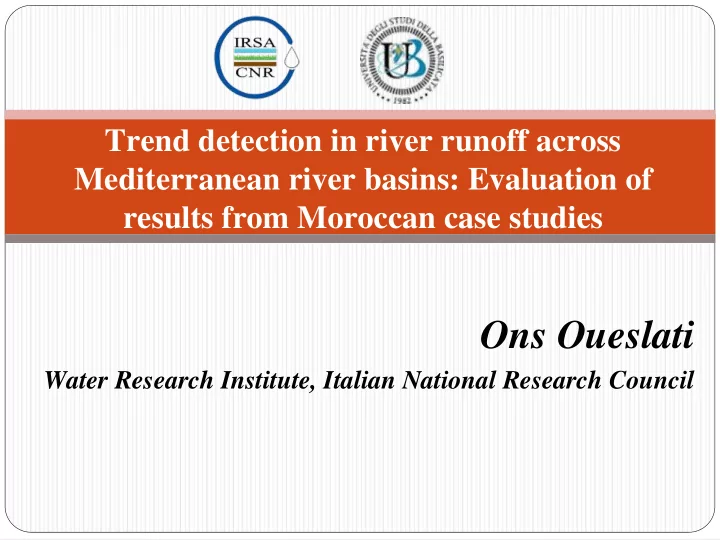

Trend detection in river runoff across Mediterranean river basins: Evaluation of results from Moroccan case studies Ons Oueslati Water Research Institute, Italian National Research Council
Introduction � Within the climate change debate, the subject of trend detection in hydrologic data has received greater attention during the last decades. � Identification of trends in long term runoff is one of the important themes in hydrologic science (NRC, 1991). � Trends in historic streamflow series might be caused by anthropogenic influences in the catchment, e.g. river regulation, dam construction or irrigation. Another reason for trends is climatic change.
Introduction Mediterranean countries and their Mediterranean regions Mediterranean-type ecosystems is likely to be especially affected by climate change because of reduction in rainfall (IPCC, 2007). Decrease in water resources
Material and methods Study area Semi-arid climate � High variability of rainfall regime: difference between low and high flow can be extreme � Flash flood
Material and methods Data used for trend analysis Type: Annual and monthly mean flows time series Source: Global Runoff Data Centre (GRDC, 2009) Period of analysis:1960 to 1987.
Material and methods 3 analytical procedures of trend analysis 1. Rescaled Cumulative Departures Graphical techniques 2. LOWESS technique 3. Mann-Kendall test Statistical test
Material and methods Rescaled Cumulative Departures The rescaled cumulative departures of the monthly mean streamflow at each streamflow site were computed as the cumulative sum of the differences between the monthly value and the monthly mean for the period of record, divided by the monthly standard deviation for the period of record (Garbrecht and Fernandez, 1994), the values are dimensionless. This procedure allows fluctuations and trends in flow to be visualized and was used to identify extended wet and dry periods and to compare general trends among the streamflow sites. Periods of negative slope indicate periods of monthly streamflow which are less than the mean; periods of positive slope indicate greater than normal streamflow conditions. The steepness of the slope indicates the magnitude of the deviations from normal conditions.
Material and methods LOWESS techniques LOWESS is a locally weighted scatterplot smoothing technique (Cleveland, 1979). It is a data analysis technique for producing a “smooth” set of values from a time series which has been contaminated with noise. The basic idea is to start with a local polynomial least squares fit and then to use robust methods to obtain the final fit. This technique was used to smooth the monthly flows and to further identify possible trends.
Material and methods Mann-Kendall test The Mann-Kendall test is a non parametric trend test. It is therefore more suitable for detecting trends in hydrological time series, which are usually skewed and may be contaminated with outliers. The Mann-Kendall trend test is based on the correlation between the ranks of a time series and their time order. For a time series X= (X1, X2, X3, ….., Xn), the test statisticis given by: ( ) ( ) = -1 = − = − 0 sign sign a x x R R ij j i j i 1 and Ri and Rj are the ranks of observations xi and xj of the times series, respectively.
Results 1 Wet Dry Wet Wet Dry Line of zero cumulative departure Rescaled Cumulative Departures of montlhly mean streamflow, 1960-1987 � Almost the same general patterns for all the stations during the period of record � The period 1980-1987 was one of less-than-normal runoff. This drought appears to have been the longest on record (1960-1987) at all sites.
Results 2 � LOWESS-smoothed monthly mean flows have the same general pattern for the period of record. � Flows exhibited a generally decreasing trend which is more obvious from early 1970s. LOWESS-Smoothed plots of monthly mean flow, 1960-1987
Results 3 Mann-Kendall trend test results Station Test statistic Critical values (Statistical table) Result a=0.1 a=0.05 a=0.01 Anzegmir -3.095 1.645 1.96 2.576 S (0.01) Dar El Caid -2.498 1.645 1.96 2.576 S (0.05) Azib Soltane -3.433 1.645 1.96 2.576 S (0.01) Ourtzagh -1.962 1.645 1.96 2.576 S (0.05) Pont du Mdez -2.34 1.645 1.96 2.576 S (0.05) Bab Ouender -2.087 1.645 1.96 2.576 S (0.05) Long-term annual runoff trend using the Mann-Kendall test showed that all stations have a statistically significant decreasing trend at 5% and 1% confidence level
Conclusions � Identification of changes in streamflow records is challenging. � As presented in this work a set of different procedures can be used to search for changes in streamflow conditions. � The rescaled cumulative departures time series of monthly flows exhibit a long drought starting from 1980 to 1987 in all sites. � LOWESS-smoothed monthly mean flows have the same general pattern for all the stations during the period of record(1960-1987). Flows exhibited a generally decreasing trend which is more obvious from early 1970s. � Statistical testing using the Mann-Kendall test show a significant decreasing trend in annual runoff.
Recommend
More recommend